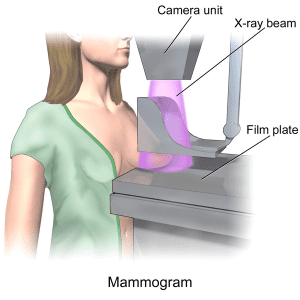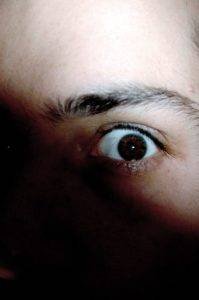
Table of Contents
How painful a mammogram is going to be is the question you’ll expect will be going through the mind of any woman thinking of having her first mammogram.
Mammogram screening is not supposed to hurt. The machine’s compression plates are designed to compress breasts without creating pain and discomfort. Unfortunately, this is not the experience of many women who have had to go through screening.
It is a general belief that the majority of women have no pains or discomforts about mammography. There is a paucity of analysis of the pain level felt and research done in this area comes up with conflicting data.
The compression.

The force of the compression applied varies among patients with an average of about 2.42psi (that is, pounds per square inch).
Compression level is decided at the discretion of the mammographer based on factors like the size of the breasts being screened and your pain tolerance level. For some women, it’ll be higher than average while for others it could be well below the figure.
However, optimal compression is necessary to get clear images and avoid the superimposition of breast structures. Abnormal growths or cancers can be hidden by superimposition.
How painful is a mammogram going to be?

There is a wide discrepancy in available research data on the incidence of pain resulting from mammography. This may be a result of the research methodology employed.
Nonetheless, in one research, 66.5% of women indicated they felt pain but mostly from mild to moderate pain that won’t prevent them from continuing with their regular screening.1
In another research, 93% of women reported having felt pain during the screening, yet mostly mild or moderate pains. Be that as it may, mammograms are known not to be painful.2
The discomfort could be what some women tag as pain but this so-called pain goes away soon enough after the test.
So pain resulting from mammogram screening exists but it’s nothing to be so bothered about that it’ll prevent you from benefitting from the life-saving breast examination, besides, a lot of women don’t feel any pain or discomfort at all.
There are factors responsible for this which we’ll discuss in the latter part of this article.
Risk factors to pain.
Whether you’ll fall among the class that feels no pain or discomfort or those that have very mild or moderate pain, may depend on any of the following factors.
1. Presence of breast implants: Women with implants are known to feel more pain during mammograms than those without them Share on X. Some of the reasons could be the formation of scar tissue contractures around the implant apart from the formation of breast microcalcifications in the same area.
Both of these developments will result in pain as the implants are shifted to position the breast tissues for compression.
As someone who has had to deal with various soft tissue contractures in my patients, I can tell how painful it could be.
2. Existing Breast tenderness: If for any reason, your breasts already hurt before going in for mammography, you’ll expect to feel pain during your screening.
3. Expectation of pain and discomfort: Research has shown that women who go in for mammogram screening expecting to feel pain do. However, the level of pain they report is hardly anything close to their expectations and they look forward to their next screening.
4. Period in your menstrual cycle: Due to hormonal changes in premenopausal women, the breasts show some tenderness at certain times during their cycle. If at such times they present their breasts for screening, discomfort can be expected.
5. Caffeine: Caffeine is known to make the breasts tender. People who take it can expect pains that they may attribute to breast screening.
6. Pre-existing breast disease: For anyone having an existing disease that elicits pain, your mammogram screening will almost certainly be painful.
7. Positioning: The way your breast is positioned including the height of the machine’s plates, if not suitable, may cause discomfort.
8. Technician’s or mammographer’s skill and experience: The technician’s knowledge or skill will impact how your breasts are handled and positioned. If not correctly done, you may feel discomfort or even pain.
9. Breast size: Since it’s a determining factor in the level of compression to be applied, it could also determine the discomfort that can be felt, if at all.
How to reduce pain felt during mammography or manage it after.
Mammogram screening usually isn’t expected to be painful. In case you are one of those wondering how painful is a mammogram, here are a few things you could do to make it more comfortable.
I’ll start with things you should do before your screening, during your screening, and after.
Pre-Screening.
1. Choose a very good center near you, where you’ll be comfortable doing it. A center that works with you on deciding the level of compression should also be considered.
2. Avoid caffeine days to your test so it doesn’t contribute to breast tenderness.
3. Also reduce salt intake days to your test since it could make your breasts bloated and prone to discomfort during screening.
4. Plan to have it done with an experienced, friendly, and skilled mammographer.
5. If you are premenopausal, schedule the appointment for a time your breasts will be less tender.
6. If you’ve had a mammogram before and experienced pain, you may want to talk to your doctor to know if you could take a pain reliever not less than 30 minutes before your appointment.
During Screening.
1. Talk to the technician about your concerns regarding pain and discomfort.
2. Practise breathing exercises, listening to cool music, or anything that makes you relaxed before your screening.
3. Demand for gentle compression and if at a point it gets rather very uncomfortable, inform the mammographer to see if there can be an adjustment.
4. You may want to hold your breath for a few seconds during the actual imaging so the mammogram doesn’t appear blurred. Doing this could spare you the experience of having it repeated.
Post-screening.
It’s not expected you’ll feel pain but where for any reason pain results, it usually clears shortly afterward. You may want to talk to your doctor if you could take an over-the-counter pain reliever if it persists longer than expected.
Going by a case report in the National Library of Medicine, report any pain that persists for days to your doctor for an investigation to ensure it isn’t the result of an underlying issue.3
Do keep in touch by signing up for our newsletter:
Mammogram side effects.
No serious risks are known anywhere by research or case studies that should discourage anyone from screening for breast cancer. Some of the identifiable risks are:
1. Radiation risks: The amount of radiation from a single screening is rated to be similar to the same background environmental radiation we are naturally exposed to over several days. It is considered very safe and shouldn’t be a course of concern.
2. False positives: The problem with this is the hassle of being subjected to unnecessary diagnostic tests, psychological trauma, and biopsies with the accompanying expenses.
However, when weighed against the impact of mammography on the general reduction in mortality, you’ll understand why this is a small sacrifice so we all have to endure.
3. Pains and discomforts from compression: This is one of the main issues on this subject and the topic of this article. In the vast majority of cases, these are minor and a lot of women don’t even feel anything at all. Moreover, what is believed to be a painless screening method is being developed and could replace mammography.
4. Recalls: It becomes necessary when there are symptoms, screening reveals abnormalities, and so on. When this occurs, additional imaging and other investigations are done to rule out cancer and in most cases, it’s ruled out.
5. Overdiagnosis: Some cancers would’ve never progressed to become life-threatening or symptomatic. The discovery of these types of cancers is called overdiagnosis in a Breast Cancer Research publication but you know what?4 Since there is yet no way of telling cancers that would progress from the harmless, this shouldn’t be a reason to condemn mammography.
We do indeed find ourselves on the wrong side of the equation in regards to mortality should we stop treating cancerous tumors on the assumption they could turn out harmless.
Overdiagnosis isn’t even among the major considerations regarding the side effects of mammography. A publication in the National Library of Medicine (NLM) has adjudged numbers 2, 3, and 4 to be the principal risks yet they are not so significant compared to the benefits of screening.5
Painful mammogram forums.
Controlled trials in the US and Europe, on women above 50 years have revealed that regular screening reduces mortality by as much as 30%, yet women are prone to skip these screenings out of fear of pain and discomfort as published in the Journal of Medical Imaging Radiation Oncology.
Perhaps, rather than sit at home listening to your fears and that loud mischievous voice that tells you the mammogram machine will crush your breasts, it might help to discuss with fellow women in forums.
One very good and trustworthy one is by Cancer Research, UK. A few other organizations also have forums like:
Breast cancer now,
Homesteading, and
Macmillan cancer support.
Final Words.

I want to believe that even without a first-time experience, you are now able to answer the question of how painful a mammogram is.
In case you missed that part, I started earlier in this article that you can control the amount of compression done during mammography Share on X. The Food and Drug Administration passed a vote of confidence on this procedure as far back as Sept. 2017.
The system where you control the amount of compression on your breasts has been found not to affect the quality of the image while reducing whatever pain or discomfort you are liable to have.
I think this is a highly welcomed procedure, after all the breast is yours and not the mammographer’s, so you should have a say on what happens to it.
While mammography continues to dominate discussions on breast screening, a painless, light-based, and non-radioactive procedure, which may replace mammograms is on the offing as published in the National Institute of Biomedical Imaging and Bioengineering.
By that time I hope women will stop dodging breast cancer screening as they are known for. I feel your concerns though.
If you found these useful, do keep in touch by subscribing to my newsletter.
Meanwhile, your input on this subject will be very much appreciated.
References.
- Hafslund, B. (2000). Mammography and the experience of pain and anxiety. Radiography, 6(4), 269-272. https://doi.org/10.1053/radi.2000.0281 ↩︎
- Kashikar-Zuck, S., Keefe, F. J., Kornguth, P., Beaupre, P., Holzberg, A., & Delong, D. (1997). Pain coping and the pain experience during mammography: A preliminary study. Pain, 73(2), 165-172. https://doi.org/10.1016/S0304-3959(97)00114-0 ↩︎
- Cann, S. H., Thornton, I., & Finegan, R. (2016). Case Report: Growing concern following compression mammography. BMJ Case Reports, 2016. https://doi.org/10.1136/bcr-2016-216889 ↩︎
- Løberg, M., Lousdal, M.L., Bretthauer, M. et al. Benefits and harms of mammography screening. Breast Cancer Res 17, 63 (2015). https://doi.org/10.1186/s13058-015-0525-z ↩︎
- Feig SA. Adverse effects of screening mammography. Radiol Clin North Am. 2004 Sep;42(5):807-19, v. doi: 10.1016/j.rcl.2004.06.013. PMID: 15337417. ↩︎































































































































































Thanks for spending the time to write this. It is been highly useful for me. Big thumbs up for it.